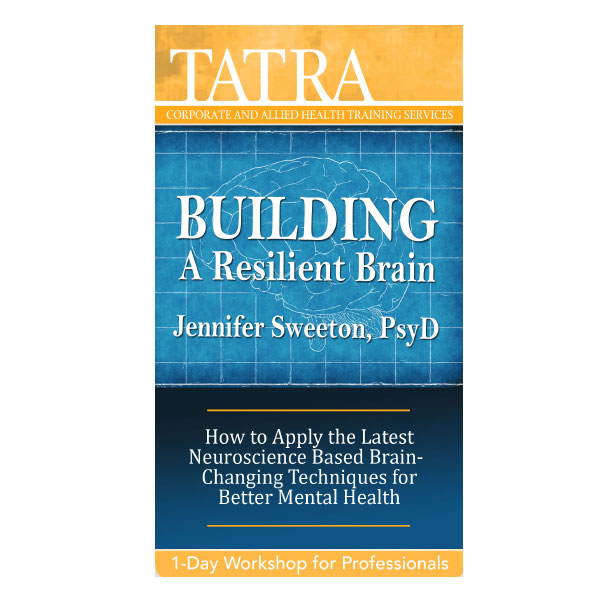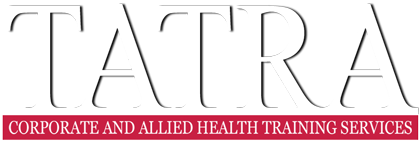Building a Resilient Brain: How to Apply the Latest Neuroscience Based Brain-Changing Techniques for Better Mental Health

Jennifer Sweeton, PsyD, MS, MA
This one-day workshop, led by clinical psychologist Dr Jennifer Sweeton, shares the most up-to-date neuroscience research discoveries and teaches highly effective brain-based techniques aimed at facilitating recovery from mental illness. Join Dr Sweeton for this program and discover how to develop and implement personalized, neuroscience-based treatment plans, techniques, and interventions for your clients!
Course Dates
Sydney: 31 July 2019, SMC Conference & Function Centre
Melbourne: 2 August 2019, Bayview on the Park
Brisbane: 5 August 2019, Mantra on Queen
Adelaide: 7 August 2019, Next Gen Memorial Drive
Perth: 9 August 2019, Wollaston Conference Centre
Canberra: Cancelled
9:15am to 4:30pm
Attend this experiential seminar and take home some of the latest evidence-informed, easy-to-implement, brain-based interventions that you can start using with clients tomorrow! Becoming a neuro-psychotherapist does not require a comprehensive understanding of the entire brain, which is daunting, time-consuming, and ultimately unrealistic. Rather, to become brain-based clinicians, therapists need to understand the central key areas of the brain involved in mental health and mental illness, how they function, and how therapy can change them in positive ways. This seminar gets to the heart of what is most important for clinicians to know about the brain without the academic jargon or dry lectures, with an emphasis on how to use what we know about the brain to help clients heal. Mechanisms, or “active ingredients” of various techniques are discussed with regard to brain areas impacted, allowing clinicians to better understand not only what works, but why it works.
This one-day workshop, led by clinical psychologist Dr Jennifer Sweeton, shares the most up-to-date neuroscience research discoveries and teaches highly effective brain-based techniques aimed at facilitating recovery from mental illness. Join Dr Sweeton for this program and discover how to develop and implement personalized, neuroscience-based treatment plans, techniques, and interventions for your clients!
Program Outline
Part 1: Brain Basics
- Getting back to basics: The Central Nervous System and Peripheral Nervous System
- Neurons
- CNS: Brain and spinal cord
- PNS: somatic and autonomic nervous systems
- The Autonomic Nervous System and “Brain-Body Connection”
- Literal, physical link between the brain and body
- Two branches of ANS: Sympathetic and Parasympathetic
- Physical correlates of ANS arousal
- 1,400 biochemical reactions associated with ANS arousal
- Fight and flight in the ANS
- Freeze (immobility and collapse) in the ANS
- Brain Basics
- Triune Brain
- Top 12 mental health areas of the brain will be emphasized
- Survival areas not created for optimal mental health
- Survival brain – relevant to mental health clinicians?
- Limbic brain areas of interest
- Mental Health Brain Structure 2: The Amygdala
- Mental Health Brain Structure 3: The Thalamus
- Mental Health Brain Structure 4: The Hypothalamus
- Mental Health Brain Structure 5: Hippocampus
- Mental Health Brain Structure 6: The Insula
- Mental Health Brain Structure 7: The Nucleus Accumbens
- Cortical brain areas of interest
- Mental Health Brain Structure 8: The Left Dorsolateral Prefrontal Cortex
- Mental Health Brain Structure 9: The Right Dorsolateral Prefrontal Cortex
- Mental Health Brain Structure 10: The Ventromedial Prefrontal Cortex
- Mental Health Brain Structure 11: The Anterior Cingulate Cortex
- Mental Health Brain Structure 12: The Right Temporal Lobe
- Other brain areas to note:
- Brain Connections, Pathways, and Networks
- Networks vs Pathways
- Afferent and efferent connections
- Networks:
- Pain Pathway
- Stress Pathway
- Reward Pathways
Part 2: Brain Profiles of Mental Illness, and Clinical Implications
- Brain Development in Children
- When all goes well
- Timeline for child/adult brain development (visual depiction)
- When all does not go well – developmental and complex trauma in the developing brain
- The Role of Attachment in the Developing, AND Developed Brain
- First 18 months all right hemisphere – critical period #1 for attachment
- Attachment style forms and can be modified during first couple of decades of life
- Healing attachment in children
- Healing attachment in adults
- The role of the therapeutic alliance in healing attachment
- The neuroscience of social medicine
- Mirror Neurons
- “Gandhi neurons” – Ramachandran
- Our “oneness with others”
- Without skin experiences blend, neural influence is powerful
- The alliance = mirror neurons in the emotional centers of the brain
- Harnessing the power of mirror neurons in therapy to build the alliance
- The alliance as a brain-based, evidence-informed set of techniques/processes
- The dark side of mirror neurons: Burnout, compassion fatigue, overidentification, unhelpful countertransference
- Combating the dark side of mirror neurons during therapy: Activate your reward centers, shift from empathy to compassion, establish boundaries
- The upside of mirror neurons: This is how you heal attachment. Brains exert influence on one another, resulting in aligned brain waves, lowered cortisol, etc.
- Brain Profiles of Common Disorders
- Similar brain regions involved in various disorders, but profiles are very different. Understanding brain profiles of the disorders clinicians treat critical for taking a brain-based approach.
- This is Your Brain on Depression
- This is Your Brain on Bipolar Disorder
- This is Your Brain on Anxiety
- This is Your Brain on OCD
- This is Your Brain on GAD
- This is Your Brain on Trauma
- This is Your Brain on Addiction
- This is Your Brain on Schizophrenia
- This is Your Brain on ADHD
- This is Your Brain on Autism
- Now What Do We Do? Three Ways to Change the Brain
- Three options for changing the brain: bottom-up, top-down, or horizontally
- Bottom-up – working through the body to change the brain
- Top-down – working with the mind/thoughts to change the brain
- Horizontal – working across modalities or hemispheres to change the brain
- Examples of interventions/techniques falling into the three categories
- Where to start: The Five Phase Neuropsychotherapy Treatment Roadmap
- The role of behavioral techniques/interventions in the treatment roadmap
- How to implement the five phases: Titration and pendulation
- Titration – taking it “one step at a time,” gradual increases in challenge/discomfort
- Pendulation – dysregulation (amygdala activation) in contained, safe space
- Distress thermometer handout for clients
Part 3: Brain-Changing Interventions
- Phase I: Develop Therapeutic Alliance
- Alliance-building, mirror neuron-activating tools
- Mirroring
- Following
- Eye contact
- Body language analysis
- Building trust
- Setting boundaries
- Rethinking transference and countertransference
- Supporting research
- Phase II: Get the Client Into Their Body
- Proprioception techniques
- Interoceptive exposure techniques for trauma
- Sensory awareness techniques
- Supporting research – what brain areas change
- Movement-based techniques
- Poses and stances
- Phase III: De-activate subcortical structures
- Bottom-up techniques:
- Body-based:
- Breathing
- Phase IV: Activate cortical structures
- Meditations
- Cognitive Tools
- Phase V: Alter brain connectivity (strengthen lateral and downward connections)
- Body-based for weakening upward connections
- Meditations for strengthening lateral and downward connections
- Coming up with a client-centered treatment plan using The Five Phase Neuropsychotherapy Treatment Roadmap
- Roadmap handout
- Infographic
- APS: Activities do not need to be endorsed by APS. Members can accrue 7 CPD hours by participating in this activity
- AASW: Members can accrue 7 CPD hours by participating in this activity
- ACA: Members can accrue 5 CPD points by participating in this activity
A certificate of attendance will be emailed to participants following the workshop.


